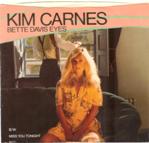I am a lover of lyrics especially meaningful ones, but back in the early eighties when I was working at Radio One, one of the first songs people asked me the meaning behind or what they were singing about was Brass in Pocket by The Pretenders. I was constantly getting asked why Chrissie Hynde was singing ‘I’m feeling myself’ then a close listen revealed she was singing ‘I feel inventive’ The same thing happened a couple of years later when I was asked what does Kim Carnes mean when she sings ‘And she knows what it take to make a crow blush’. Of course it’s pro blush, but not originally. Let’s look at that song more closely.
On the face of it, it sounds like a friendly pop tribute to the great actress, but is there a hidden meaning? Sadly, I’m not sure we are going to find out here as there are two versions of the story. There’s a good chance that Kim Carnes didn’t know either.
The song was co-written by Jackie DeShannon and Donna Weiss in 1974 and originally recorded in a 1920s Jazz style by Jackie on her 1975 album, New Arrangement. She claims she got the idea for the song after watching the 1942 Bette Davis movie Now Voyager. When Jackie was interviewed a few years after it was a hit she said of its inspiration. “Well, we loved Bette Davis. We were always talking about what great movies and how we love her. Anyway, Donna had this idea and she brought a lot of papers over one day. She said ‘Do you think you can make anything out of this?’ So I kind of went through and looked at some lyrics and put some things together and we wrote this song. We went to demo it and we did a pretty good Rock version.”
Jackie was going to release it herself but, she explained why she didn’t, “It was a disagreement on the arrangement with Val Garay who was producing it. We had a demo that was much closer to the Kim Carnes version, and at that particular time, I wouldn’t have had the leverage to insist that we do it that way…I was really unhappy with the way it ended up. He was very adamant about turning it around into another version. So, time went on and Donna was sending the demo around to different people. She was taking some other songs over to Kim Carnes because she was recording and she just happened to have that demo with her and she gave it to Kim and the rest is history.” Did they write the song equally? “Well, I think probably more Donna’s lyrics although I did have some say, but basically Donna did most of the lyrics and I did the music.”
When Donna Weiss was interviewed by Fred Bronson for the American Number Ones book, he asked her who or what the inspiration was and she replied, “Guess what! I’ve never told anybody that before – and I can’t. I know it sounds ridiculous but I can’t tell the exact derivation aside from, of course, Bette Davis in, I think, a movie called Jezebel, the way she look then with her white hair, but that’s not really the inspiration for the song.”
This is what producer Val Garay said when he first heard it, “When the original demo of the tune was brought to me it sounded like a Leon Russell track, with this beer-barrel polka piano part. I asked my keyboard player friend Bill Cuomo what he can do and he came up with the signature synth riff, using the then-new Sequential Circuits Prophet-5 synthesizer which now defines Carnes’ version. I also had my assistant go out and buy the cheapest and cheapest-sounding drums too. The song was recorded completely live in the studio on the first take.”
There was much confusion over whether the lyrics are crow blush or pro blush. Jackie DeShannon sings ‘crow’ in her original version, and Kim Carnes recorded it as ‘pro’ from a mis-transcription of the lyrics. This error has proliferated through numerous cover versions. The phrase ‘to make a crow blush’ is an early 20th century Midwestern United States colloquialism meaning that one could unease someone with little effort, and the arranger from Carnes’ version was unfamiliar with the term.
When the song was first issued in 1981, Bette Davis, who was then 73 years-old, wrote letters to both Jackie DeShannon and Donna Weiss as well as Kim Carnes to tell how much she appreciated being part of modern times. The song went on to win a Grammy and then Davis sent them all a rose as well. “It was just fabulous” recalled Weiss.
The song entered the chart on the first week of May 1981 both in the UK and the US. Here it peaked at number 10, in the States it spent nine weeks at the top and went on to become the second most successful song of 1981 only beaten by Olivia Newton-John’s Physical which was there for 10 weeks.
